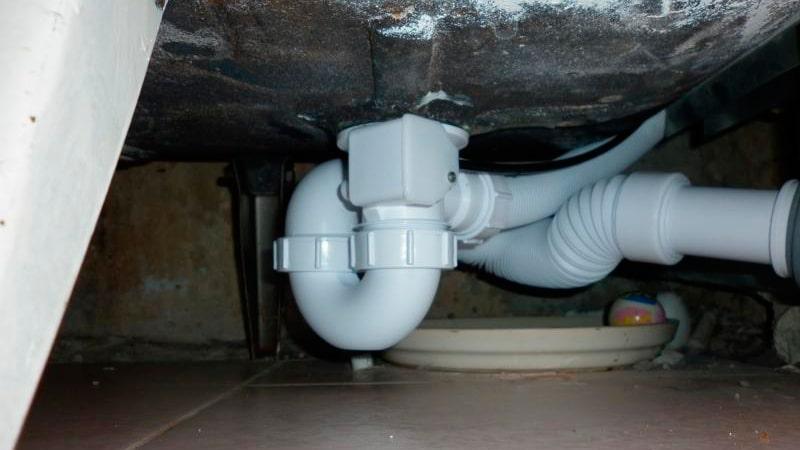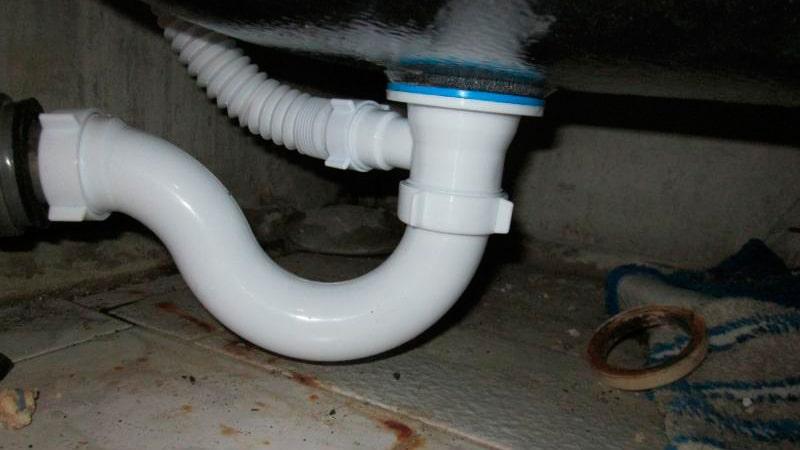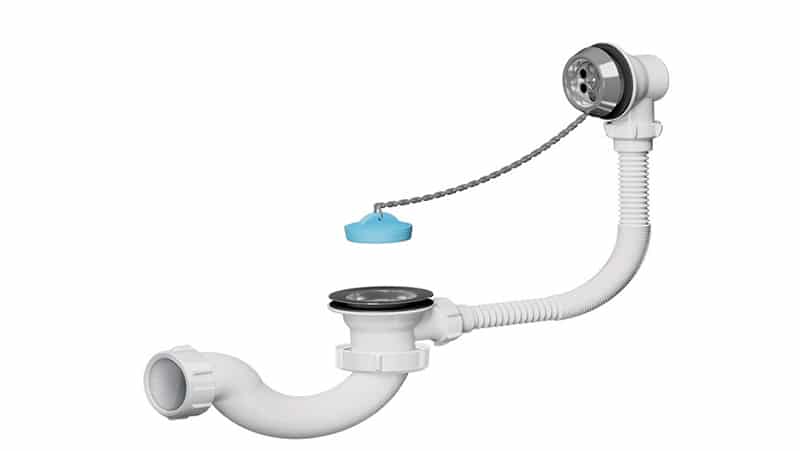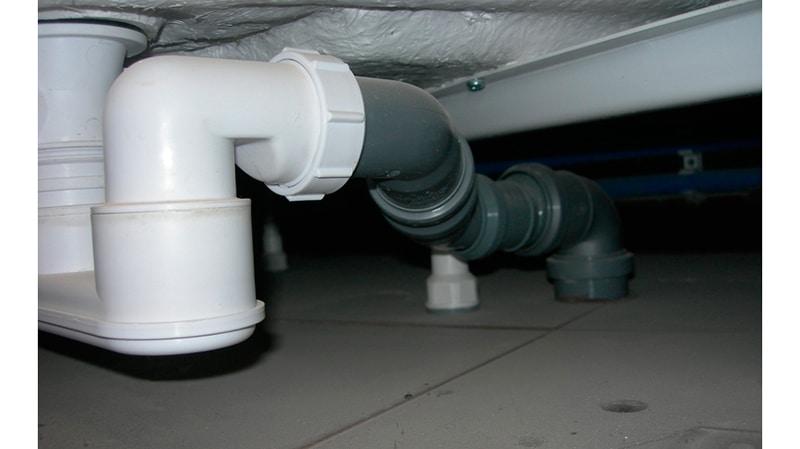The siphon in the overall structure of the plumbing system plays the role of a buffer that protects the bathroom from the penetration of gaseous substances with an unpleasant odor from their sewage system.
Before deciding which bath siphon is best , you need to analyze the main factors affecting the correct selection. The basis of the work of any model, oriented specifically for the bath, is the need to ensure the main drain of the mass of water from the font and to prevent flooding of the room when the maximum level is exceeded. The first function is performed by a hole at the bottom, and the second is an overflow on one of the walls of the inner surface of the bath.
Based on this, the siphon is equipped with two outlets that are connected directly in front of the water seal, providing a general drain into the sewer. The variety of bath configurations (corner, round, rectangular, oval, polygonal) makes you think about which siphon model will be the most successful.
Installing a siphon on a bath
Another factor to consider before purchasing a siphon is the material of the bath itself. Conservative cast iron along with steel are gradually giving way to innovative acrylics. There are also more daring modifications of stone and wood fonts. Such an analysis becomes important, since in addition to universal siphons, which are easily adaptable to different conditions, due to the flexibility of plastic pipes, there are specialized samples of siphons oriented to a specific bath model.
Siphon typology according to design
The solution to the problem of how to install a siphon on a bath depends largely on its design.
Tubular siphon
The design is based on the ideal in its simplicity shape of the pipe bend in the form of a horizontally located letter S. The first bend from the drain, ending in an upward segment, becomes a buffer zone between the sewer system and the atmosphere of the bathroom itself, since it constantly contains water. All other streams, overflowing over an elevated area, rush into the sewer.
The tightness of the overlap is provided by a plug, for the manufacture of which plastic or dense rubber is mainly used.
Due to its small dimensions in the vertical direction, the tubular siphon is often mounted in conditions of limited height in the space under the bathroom.

Bath siphon
Advice! The most mobile is the flexible pipe, which allows you to optimally adjust the position of the siphon in different situations.
Advantages of tubular modification:
- clear design diagram;
- affordable price;
- ensuring the rapid drainage of even contaminated water with suspended particles of sediment due to a sufficiently large cross section;
- low probability of dense blockages;
- easy installation;
- ease of use.
There are no significant shortcomings. Some users do not like the need to constantly monitor the removable plug. It is easy to eliminate such a negative nuance if you fix the cork on a flexible chain, which prevents it from falling to the floor. For ease of maintenance, you can find a sample of a siphon with a flat bottom surface, which can be disassembled if preventive cleaning of the device is required.

Connecting a siphon to a bath
Bottle siphon
The name of the bottle siphon is due to the design features of the device in the form of a bottle, which has a branch pipe on the side. It is installed on the pipe leading from the drain. The height of the location of the branch pipe relative to the bottom of the siphon determines the volume of water that is constantly in the water seal.
Advantages of bottle modification:
- small horizontal dimensions;
- external aesthetics;
- easy cleaning.
Thanks to the collapsible design, the question of how to clean the siphon in the bathroom is solved quickly without much effort. In improved types, an additional branch pipe with a special plug is provided at the top of the siphon, to which a washing machine can be connected.
The main disadvantage is susceptibility to blockages, which often form around large particles of trapped debris, fibers or hair.
Ladder
This is a flat version of the siphon with a low height value without overflow. It is used if you want to equip a drain in the bathroom floor.
What material is preferable for siphons: an analytical excursion
There are several types of materials that have already passed a long operational period and can be evaluated with the identification of positive qualities and possible disadvantages.
Cast iron
The material is durable, time-tested with good casting performance. Cast iron siphons are well adapted to standard baths of the same material. They are gradually losing their relevance, since they do not allow changing the dimensions, therefore, they may not be suitable for other types of baths, which threatens to break the tightness at the joints.
A significant disadvantage is the rapidly forming deposits and the impossibility of complete cleaning due to the roughness of the inner surface of the siphon. In addition, cast iron becomes rusty over time.
Plastic
Modern modifications of siphons made of plastic with high strength characteristics are quickly becoming in demand due to their exceptional resistance to decay and corrosion damage. Products with an absolutely smooth surface do not retain fat, which ensures that the inside is kept clean. The flexibility of the plastic makes it possible to adapt the siphons to various bath modifications. Chemicals can be used to clean these siphons without the risk of deformation. The disadvantages of experts include the loss of strength from external factors (air oxygen, ultraviolet radiation), which limits the operational duration.

Connecting the siphon to the sewer
Brass
An alloy of several components, the base of which is copper, and the alloying one is zinc - this is a traditional brass. Sometimes a small amount of tin is added (but less than that of zinc). It is a durable and decorative material that is resistant to temperature changes and does not corrode. Due to the durability of the external excellent protection, for example, by chrome-plating, the siphon, which has a rather high cost, harmoniously fits into luxurious bathroom interiors.
Automation in the sanitary ware sector
Even products as simple in design as siphons have received new features that make them easier to operate. Semi-automatic and automatic models are offered to consumers.
Semi-automatic
Its principle of operation is the ability to control the plug on the drain hole through the drive by means of a mechanism installed on the top overflow cover. There are three control options.
- Before filling the bath, when pressed, closing the drain, an overflow opens on the stopper in parallel. To empty the container, it is enough to close the overflow, press its lid, which ensures automatic opening of the lower drain hole.
- The control of both opening and closing of the drain is completely transferred to the overflow cover, made in the form of a rotating handle.
- A special lock located on the plug ensures that the hole is closed when pressed. To drain the water, just press it again.
Important! A semi-automatic siphon, made of low-quality materials, quickly turns into an inoperative unit due to leaks that arise from the presence of additional holes that serve as outputs of movable control elements.
Auto
Microprocessor control of a wide range of processes has added comfort to users. Select the set temperature when drawing water, maintain it for the required time, close the drain at the beginning of use, open it at the end of the procedure using the conveniently located multifunctional button. Such a siphon, made of high quality brass, is practically not susceptible to contamination, but it will need constant power supply.
Traditional siphon device
Conventional mechanical siphons made of plastic, due to the elasticity of the material, uncomplicated design, simple installation, remain the most popular among similar sanitary products.

We install the siphon on the bath with our own hands
Siphon device:
- stopper (rubber, plastic), sometimes with a stainless steel top finish, providing a hermetic closure of the drain;
Note! Convenient stainless chain, included in the set of rather expensive models, allows you to securely attach the drain plug to the overflow grate.
- grids with rubber gaskets to protect the overflow and drain from large particles of debris. Inexpensive types are made of plastic, and polished stainless steel is used for more prestigious and expensive models.
- rubber gasket, which serves as a reliable barrier for moisture flow at the junction of the branch pipe and the drain hole;
- an outlet pipe with mounting relief rings and a rim designed to securely fix the gasket during installation;
- stainless steel screw connecting the branch pipe and the grill;
- nut (made of copper, stainless steel, brass), pressed directly into the body of the branch pipe;
- plastic tie nuts;
- a removable elbow designed for operational maintenance, in particular for cleaning from sludge;
- tapered gaskets, ensuring the tightness of the connection between the branch pipe and the siphon body;
- adapters;
- sewer outlet (it is more convenient to use a corrugated pipe, which is easier to adapt in size, although the usual version of a straight hose is also suitable);
- flexible hose-accordion;
- an outlet connected to an elastic corrugated hose for overflow, the height of which can be changed if necessary.
Algorithm of actions when installing a siphon on a bath
The appearance of wet spots and even puddles on the floor indicates that it is time to take serious measures. First, the old siphon is dismantled. The plastic product is easy to disassemble. If the nuts are over-tightened and it is difficult to unscrew them, you can simply remove the siphon in parts by sawing it. With a cast-iron analogue, which has served for more than a decade, as a rule, it is not easy to cope with it, since the fasteners are tightly soldered due to corrosion processes. Craftsmen pick up a hammer and a strong chisel, or use a grinder. You have to work carefully so as not to damage the bath itself if it is not planned to replace it.
The next step is to install a siphon on the bathtub with your own hands, which is quite accessible even for beginners, taking into account specific nuances.
- in order not to be in an uncomfortable position in a limited space under the bathroom, it is advisable to assemble the base parts in advance;
- the tapered gasket is positioned so that its wide base is pressed against the nut;
- Tightening nuts require care, since there is a risk of overtightening and cracking with a wrench, it is advised to tighten them by hand.

Bath siphon - do it yourself installation
Solving the actual problem of how to properly install the siphon under the bathroom, you need to adhere to a certain algorithm in practical actions:
- A decorative grille is placed, duplicated by a gasket.
- From the outside, the nipple is pressed tightly to the hole on the pre-placed gasket, while, while the screw is tightening, the gasket is held by hand in the right place in order to prevent its displacement.
- The main bend is assembled, into which a branch pipe is inserted from above, equipped with an adapter leading directly to the sewer pipe.
- At the last stage, an overflow outlet is connected to the overflow hole.
Correct installation of the siphon is peace and comfort, so you should not rush during independent actions. Any model is supplied with detailed instructions that must be carefully studied.
Installing a siphon on a bathtub with your own hands Installing a siphon on a bathtub Siphon for a bathtub - do it yourself installation Install a siphon on a bathtub - connect it to the sewer Connecting a siphon to a sewer Siphon on a bath Connecting a siphon to a bathtub
